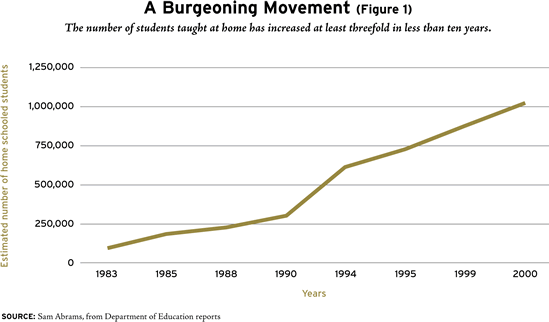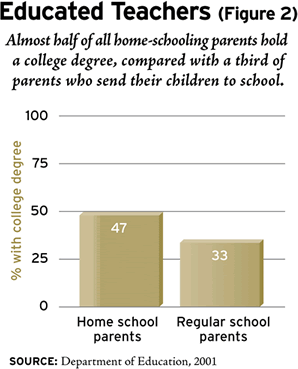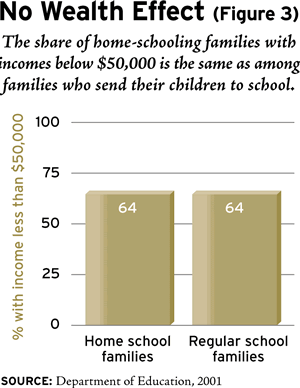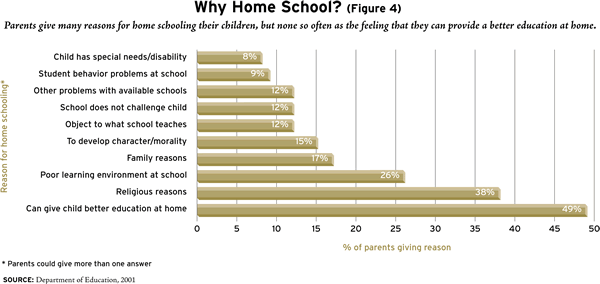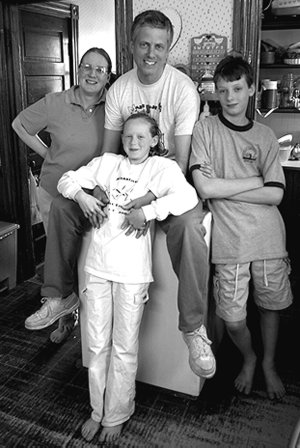 |
| Stereotyping is no longer possible in a movement that is just as likely to include Creationists as it is avid fans of Howard Gardner’s theories of multiple intelligences.
|
In recent years, home schooling, once considered a method born more of religious zealotry than a concern for academics, has captured a surprising amount of positive attention. This is due in no small part to the success of home schoolers at the nationally televised Scripps Howard National Spelling Bee. This year, 13-year-old Sean Conley of Anoka, Minnesota, became the third winner of the annual spelling bee in the past five years to have been home schooled. The previous year had been a sort of coming-out party for home schoolers: Eight of the finalists had been home schooled, with the top three slots all going to home schoolers. The winner of the 2000 spelling bee, 12-year-old George Thampy of Missouri, was also first runner-up in the 2000 National Geographic Bee. An astounding 10 percent of the 2001 spelling bee contestants were home schooled, even though home schoolers make up no more than 2 percent of the student population. Sean Conley’s parents seem to have favored an approach high on self-discovery, called “unschooling” in some quarters of the home schooling movement. “Basically, home schooling lets me learn whatever I want,” Conley told Scripps Howard. “There are a lot of different ways to home school, and the way that I did it, my parents didn’t necessarily teach me. They taught me some things, but a lot of things I just learned on my own.”
Home schooling is a small but fast-growing movement that includes, but is certainly not limited to, an eclectic mix of Christian fundamentalists, aging hippies, and inner-city minorities chastened by highly dysfunctional public schools. Their motivations range from conservative concerns about the values taught in public schools to more liberal worries that public schools stress conformity over creativity. Stereotyping is no longer possible in a movement that is just as likely to include Creationists as it is avid fans of Howard Gardner’s theories of multiple intelligences. In fact, the standardized-testing binge in many states may be the largest source of new converts to home schooling.
In the political arena, home schoolers, faced with repeated efforts to bring them within the regulatory reach of local, state, and federal governments, have developed potent defensive strategies-to the point that home schooling has become an almost invincible part of the U.S. education system. For instance, during the 1994 reauthorization of the federal Elementary and Secondary Education Act, California congressman George Miller offered an amendment that would have required all public school teachers to be certified in the subjects they teach. As reported by political scientist Morris Fiorina in The New American Democracy, advocates of home schooling such as the Home School Legal Defense Association were convinced that this might require home schoolers to obtain formal certification in order to teach their children at home. The word was quickly spread via electronic communications, and Congress was soon deluged with attacks on the amendment. Within a few days Congress received more than half a million communications from enraged home schoolers and their ideological allies. A floor amendment to kill Miller’s proposal added statutory language that exempted home schooling from the legislation; it passed 424-. For good measure, the Democratically controlled Congress then passed another amendment declaring that the legislation did not “permit, allow, encourage, or authorize any federal control over any aspect of any private, religious, or home school.” In another demonstration of home schoolers’ political clout, Congress, by unanimous consent, declared Oct. 1-7, 2000, National Home Education Week.
| “Home schoolers bring certain skills-motivation, curiosity, the capacity to be responsible for their education-that high schools don’t induce very well,” says a Stanford University admissions officer. |
The exact number of students schooled at home is difficult to pin down, but estimated growth is rapid (see Figure 1). In 1990, the federal government estimated that some 300,000 students were being home schooled. Just six years later, Patricia Lines of the U.S. Department of Education put the number of home-schooled children at approximately 700,000 during the 1996-97 school year, potentially increasing to 1 million by 1997-98. In 1997, Brian Ray of the National Home Education Research Institute estimated the home-schooling population during the 1996-97 school year at 1.15 million and predicted it would rise to at least 1.3 million by 1999-2000. The most recent survey, released in August 2001 by the Department of Education, estimated that 850,000 children-1.7 percent of all K-12 students nationwide-were being home schooled in the spring of 1999, noting that the total could range from 700,000 to 1 million students.
Two years later, let’s use a conservative estimate of 1 million students during the 2001-02 academic year. This still represents a large swath of students carved out of the public school system-twice the total number of children attending charter schools and about a quarter of the nation’s private school population.
More and more of these home-schooled students are applying for college admission. Of students taking the ACT college entrance exam, the number of students labeling themselves “home schooled” rose 35 percent between 1997 and 1998, from 1,926 students to 2,610 students. (Note that the data are limited because the American College Testing Board only began tracking home schoolers in 1997.) Between 1998 and 1999 the numbers continued to increase rapidly, from 2,610 to 3,257 students. The largest gain occurred between 1999 and 2000, when the number of home schoolers increased from 3,257 students to 4,593-an increase of more than 41 percent.
Home schoolers perform well on these college-entrance exams-slightly better than national averages, in fact. For three consecutive years, home-schooled students have scored higher on the two major college-entrance exams-the ACT and SAT-than their traditionally educated peers. For the 1999-2000 school year, home schoolers’ average score on the ACT was 22.8, compared with a national average of 21 points. On the SAT, home schoolers earned a score of 1100, compared with a national average of 1019. The 81-point difference is significant given that many college-bound students pay hundreds or thousands of dollars for SAT prep courses in an effort to raise their scores by 50 to 100 points.
Home schoolers scored highest on the ACT Reading and English test, outscoring traditional students by at least three points. Home schoolers also did better on the ACT Science test, but by only one point. On ACT Math, home schoolers scored lower than traditional students by a tenth of a percentage point. On the math portion of the SAT, however, home schoolers scored 532 points, compared with the national average of 514 points. Home schoolers also did better on the verbal portion of the SAT, scoring 568, compared with the national average of 505 points. Of course, these data only compare college-bound home schoolers with other college-bound students, thus giving an incomplete picture of home-schooling performance.
The finding that home schoolers score slightly higher than traditional students on standardized tests is not new. In 1998, the Home School Legal Defense Association commissioned the largest research study to date of home education in America. Conducted by Lawrence Rudner of the ERIC Clearinghouse on Assessment and Evaluation, the study analyzed data from the achievement-test scores of about 21,000 home-schooled students. All students took the same tests: the Iowa Test of Basic Skills in grades K-8 and the tests of Achievement and Proficiency in grades 9-12. Home schoolers scored higher than students in public or private schools at every grade level. On average, home schoolers appear to perform about three grade levels above their public school peers. It is important to note, however, that Rudner’s study was based on a survey given by Bob Jones University to a sample of families who used the university’s standardized testing program. No data exist on the percentage of home schoolers who take standardized tests; these data may be comparing the top 21,000 home schoolers with the average regular student. Nevertheless, we can safely say that Wayne Johnson, president of the California Teachers Association, was seriously misinformed in telling Time magazine, “Putting money into home schooling is throwing money down a rathole. You have no idea if that money is being spent properly or children are benefiting.” Many children clearly are benefiting.
Home schoolers also find ways to succeed outside the classroom. Besides their disproportionate success in spelling bees, home schoolers participate in debate tournaments, public-speaking contests, and competitions that involve applied math and science. For instance, Chris Mayernik, a 12-year-old home-schooled student from Fairfax, Virginia, won the 1998 Lego Deep Sea Challenge Build-a-Thon. Contestants had to build a model of a futuristic underwater exploration vehicle out of the colorful blocks and describe how the vehicle would operate. Entries were judged on their creativity, usefulness, and scientific basis. Mayernik won for his multitiered creation, a high-tech research facility dubbed the “Titanic Search Station.” Such contests are popular among home schoolers, at least in part because they provide a way to prove themselves to skeptical college admissions officers.
A Class Size of One
Rudner attributes the success of home schooling mainly to the parents, who tend to be well educated, financially secure, and greatly concerned about the education of their children. This high level of parental involvement may lead to a more rigorous academic environment at home than children would find in a traditional classroom setting. “Home schools can and do place a greater emphasis on study skills, critical thinking, working independently, and love of learning,” writes Rudner. “Home schooling is typically one on one. Public schools typically have classes with 25 to 30 students and an extremely wide range of abilities and backgrounds. Home school parents are, by definition, heavily involved in their children’s education; the same, unfortunately, is not true of all public or private school parents.”
The individualized attention of home schooling means that students can learn at their own pace and master material before moving on. The opposite is also true: they are not held back by slower students. Parents can personalize the student’s lessons, making home schooling more reminiscent of a classic tutorial system than a modern classroom setting. A minority of home schoolers even advocate “unschooling,” which allows students to determine which subjects they will study based on their individual interests rather than follow a more rigid curriculum.
Interviews with parents who home school their children reveal a more traditional emphasis on reading, writing, and arithmetic, with less emphasis on social activities like gym, band, or study hall. In many cases, home-schooled students too young for high school reported studying advanced math, Greek, and Latin, and reading full-length biographies of historical figures. In short, the curricula followed by many home schoolers are certainly no less demanding than those offered in the public schools. Parents give many reasons for home schooling their kids, from worries about safety to the failure of schools to teach values, but their chief concern is still academics. Many parents simply feel that public schools do not teach their children what they need to know.
It is easy to dismiss the success of home schooling as simply further proof of the tenacious link between family background and academic achievement. Defenders of the public school system maintain that the majority of home schoolers, children reared in financially stable, two-parent families, are those most likely to succeed in any educational setting. But the differences between home schoolers and the rest of the student population are often overstated.
Parents who home school do tend to be better educated. Almost half (47 percent) of all home-schooled students have parents who hold a college degree, compared with only 33 percent of students in schools (see Figure 2). This still means, however, that more than half of all home-schooled students learn from parents who do not hold a college degree. Unfortunately, there is no research available to determine whether the success of home-schooled children varies with parental education.
Meanwhile, there is virtually no difference between home schoolers and their peers in terms of income. In its 2001 study, the Department of Education found that an equal share-64 percent-of home-schooled students and those in schools live in households with incomes of $50,000 or less (see Figure 3). To be sure, there is often a world of difference, academically speaking, between being raised by two college graduates, one of whom stays home to school the kids while the other goes off to a well-paying professional job, and being raised by two parents without college degrees, whose combined salaries total only $50,000. More than half, 52 percent, of all home-schooled students live in two-parent homes where only one parent works, compared with only 19 percent of those in school. Eighty percent of home schoolers live in two-parent homes, compared with 66 percent of those in school. Many home schoolers are reared in strong, stable families where the parents have made a nearly Herculean commitment to their children’s education. Nevertheless, home-schooling families are by no means wealthy; they are largely middle class, with incomes slightly below the national average for all other families.
Higher Education
According to a 1997 study by the Home School Legal Defense Association, 69 percent of home schoolers go to college, compared with 71 percent of public school graduates. As a growing number of home schoolers prepare to leave home, colleges and universities will be forced to make tough decisions regarding the admission of these unique students. Home schoolers face some unusual challenges in applying for college. For instance, how much weight will admissions officers put on letters of recommendation from Mom and Dad or on transcripts produced by home-schooling parents on their home computer?
Common to most college admissions requirements is some record of what the student has achieved or learned during the home-schooling process. Many home schoolers maintain portfolios of their work and a list of their accomplishments (books read, papers written, contests entered, awards won) to submit as part of their application. As many as two-thirds of American colleges will accept transcripts drafted by parents. There are also education companies that will test students in particular subjects and provide transcripts based on their performance.
To further buttress their applications, many parents enroll their home schoolers in college summer courses and then submit their grades as proof that their students can handle college-level work. Letters of recommendation are often obtained from employers, volunteer coordinators, or outside educators. Home-schooled students are now enrolled at institutions as varied as Appalachian Bible College, Dakota County Technical College, the University of Oregon, the United States Military Academy, the University of Chicago, and Stanford University. Home schoolers are enrolled at 19 of the top 20 national universities in the country. Thirty-six home-schooled students applied for admission to Stanford during the 2000 school year. Nine were admitted and joined the 2000 freshman class. This constitutes a 25 percent acceptance rate for home schoolers, nearly double the acceptance rate for other students.
The larger question is how home-schooled students are faring in college settings. A report released at the 1997 National Christian Home Educators Leadership Conference in Boston, Massachusetts, tracked 180 students-60 from public schools, 60 from private schools, and 60 home schoolers-over four years of college. The study compared the students in five areas determined to be important to college success-academic, cognitive, spiritual, affective-social, and psychomotor skills. In academics, home schoolers ranked first in 10 of 12 indicators. Other studies have shown home schoolers to have above-average grade-point averages.
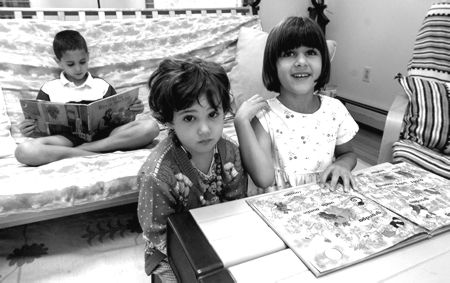 |
| On average, home schoolers appear to perform about three grade levels above their public school peers.
|
In many ways the nature of home schooling, with its emphasis on independent study, seems to prepare students for college in a way that public schools may not. “Home schoolers bring certain skills-motivation, curiosity, the capacity to be responsible for their education-that high schools don’t induce very well,” a Stanford University admissions officer recently told the Wall Street Journal.
By far the most frequent criticism of home schooling is that it fails to prepare children to deal with the social aspects of college life-or, for that matter, the social aspects of life in general. A National Education Association (NEA) position paper claims that “home-schooling programs cannot provide the student with a comprehensive education experience.” But there is plenty of evidence to the contrary. The 1997 Home School Legal Defense Association study found that 98 percent of 1,926 home-schooled students surveyed were involved in two or more extracurricular activities. More than 80 percent said they played frequently with people outside their family and went on field trips. Almost half of those surveyed indicated that they participated in group sports or music classes outside their home. Many public schools even allow home schoolers to participate in organized extracurricular events such as team sports, science labs, or social organizations. The same critics who say that home schooling is detrimental to the socialization of children, namely the NEA, would also deny them access to extracurricular activities in the public schools.
In fact, parents often mention socialization as one of the key reasons why they decided to home school their children in the first place (see Figure 4). Citing increased school violence, lack of discipline in the classroom, overcrowding, and a poor learning environment, many parents simply feel that they can do a better job at home. Furthermore, some scholars note that classroom socialization is not always a positive experience. The crucible of adolescence, especially in an environment as mean-spirited and competitive as a middle school or high school can be, may lead to weak social skills, low self-esteem, and dependence on one’s peers for self-definition.
The strongest evidence against the charge that home schoolers tend to be socially inept, however, is found in the stories of home schoolers who are enrolled in colleges and universities across the nation. Marlyn Lewis, director of admissions at Harvard University, maintains, “The home-schooled students at Harvard are indistinguishable from the other students. They are all high-caliber individuals. They are highly motivated, excel academically, and have no unusual problems adapting to campus life.”
The New York Times has done a number of follow-up stories tracing home schoolers as they leave home and enter college life. Their interviews reveal that these students do not consider home schooling a barrier to college success, do not have abnormal anxieties, and generally meet the college challenge with few difficulties. In many cases, these students were among the best on campus, noted for their high GPAs, maturity, ability to express themselves, and intellectual curiosity. None of these students expressed any difficulty adapting to college social life.
Not for Everyone
Home schooling certainly has its limitations; it is not a panacea for modern education. It seems to thrive in stable two-parent families where one parent stays home, an increasingly endangered species of family organization. Home schools also lack the resources of public education. Most home-schooling families cannot afford the variety of materials that public schools make available to students. Such limitations are most acutely felt in the sciences, where lab equipment and supplies are outside the budget of most families. Many home schoolers simply do without. In addition, many parents feel uncomfortable teaching more-demanding subjects such as physics and chemistry. It is no surprise, then, that many children are home schooled until they reach high school and then enter the public school system.
On returning to the public school system, home schoolers do not always excel. One Houston-area high-school teacher noted that home schoolers often suffer from a sort of culture shock when confronted with a modern high school. “More than anything, they have trouble adjusting to the rigid schedules and structure of a formal classroom. They are used to learning at their own pace, and they sometimes feel overwhelmed when they are hit with six subjects a day whether they like it or not. Their grades sometimes suffer because they can’t keep up.” One local area administrator also noted that home schoolers often suffer from “delusions of grandeur.” Low test scores are assumed to be the fault of the teacher or school system, when in reality the parents’ grading standards were simply more lax then those of the student’s current teacher.
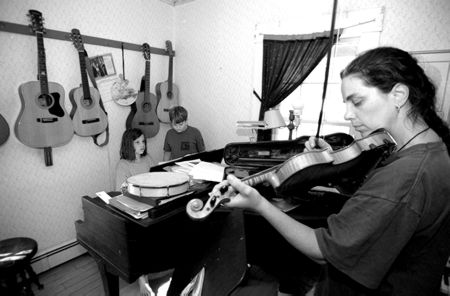 |
| For many students, home schooling appears to be a flexible, engaging method that unlocks their creativity and inspires them to greater pursuits.
|
To complicate all these issues, the data on home schooling are very limited. By definition, parents who home school take a more active role in their children’s education. It may very well be the case that these kids would succeed in most any academic environment, precisely because their parents have made education a family priority. It is thus difficult to come to definite conclusions about home schooling as an educational method.
My analysis of college admissions scores and acceptance rates suffers from the same selection effect, but perhaps to a greater degree. Here I am focusing not just on home schoolers, but on only those home schoolers bound for college. When I look at college admission tests, I am limiting the sample to those home schoolers who value higher education. The stories of superior academic achievement, higher test scores, and campus success may be less a function of home schooling than an indication of students who take their academic careers very seriously.
Nevertheless, home schoolers clearly do no worse than students educated in schools. Moreover, for many students, home schooling appears to be a flexible, engaging method that unlocks their creativity and inspires them to greater pursuits. Home schooling may not be for everyone, but for students and parents who are committed to the endeavor, it appears to be a viable alternative to public education.
-Christopher W. Hammons is an assistant professor of political science at Houston Baptist University.


